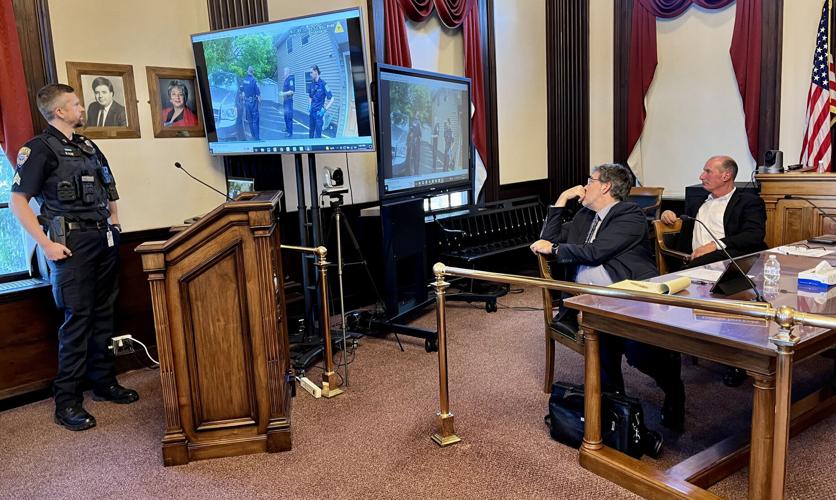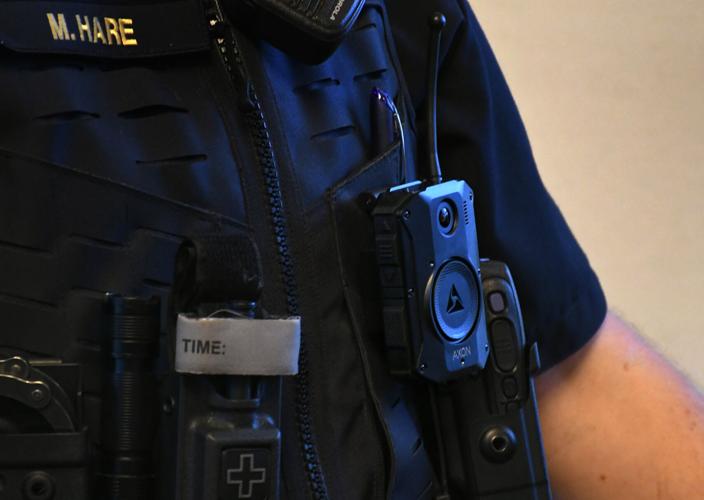AUBURN â After trying to get body-worn cameras for the last couple years, the 69Ž«Ăœ Police Department showed off their new technology Thursday night, as the agency is about to start training.
69Ž«Ăœ Police Chief James Slayton and Sgt. Matt Hare, who is running the camera program, showed the 69Ž«Ăœ City Council a demonstration of how the cameras work at a meeting at Memorial City Hall. Sixty body cameras were purchased with funding assistance from the federal government. Slayton thanked Christina Selvek, 69Ž«Ăœ's director of capital projects and grants, for her efforts regarding the grant application process.
Training for the cameras begins Oct. 4. Department members will be trained in the morning for the first half of their day, while Sgt. James Smith will oversee taser training the rest of the day. Training for every officer will happen over the course of October.
People are also reading…
"As the officers go through that (camera) training that day, they'll be issued a body camera at that point, they'll be able to keep it with them and they'll be given everything they need, so from that point forward, as they work, they'll be able to start carrying the body cameras around," Hare said.Â
The APD will be using cameras from the Axon company, Slayton said, adding "there's a majority of the departments across the nation that use Axon body cameras, and we already use Axon Tasers, so they gave us a good deal on the bundle so we saved a couple hundred thousand dollars by doing the body cameras and tasers as a bundle."
Many local police agencies use Axon, Hare said, so he has spoken to departments in Syracuse and Ithaca about their camera programs. Slayton noted the Cayuga 69Ž«Ăœ Sheriff's Office is looking into using Axon for their own body camera program and the "state police already have Axon. If we're on a scene with them and our body camera is activated, there's will also activate, so we'll have several views of incidents when they happen." Â
In a presentation Thursday at the 69Ž«Ăœ City Council meeting, 69Ž«Ăœ Police Department Sgt. Matt Hare introduces body camera footage recently recorded by Sgt. James Smith, who is testing the new technology that will soon be implemented by the full department.
Hare also noted APD will use a system where when an officer draws their gun out, if they haven't activated their camera already, their camera will be activated when their gun is drawn, as when a Taser is drawn. Slayton said Hare "has to go through all the videos," adding that Hare can redact parts of videos, such as blurring the faces of children in a video.
"If it's a medical call, juveniles, there's a lot of things we're going to have to work with (corporation) counsel on, like FOIL requests, who's going to be able to get them, whenever you're going to release that, time frames and there's going to be a lot of growing gains with this too," Slayton said. "But thank God, Sgt. Hare's been going to all these other agencies, finding out what works best for them and we'll kind of piggyback off of that and come up with our own policy that we've been working on."
The amount of redaction in a video will depend on its call type, Hare said, such as if "there's juveniles in it, whether there's somebody's identity that needs to be removed, things like that, so we'll find out how much of that takes place once we start getting FOIL requests, it's bound to start once these get into full stream."Â
Hare queued up a video from a scene filmed from a body camera worn by Smith earlier this month. Smith started wearing a camera a couple weeks ago, Hare said, "so we could start to practice with that and see how it works," as Hare and Smith went through on-site training with Axon for the cameras earlier in September. Hare said the call from the video originally came in as a possible overdose but it "ended up being more" of a mental health call.
The footage from Smith's body camera included APD, members of the 69Ž«Ăœ Fire Department and 69Ž«Ăœ City Ambulance personnel at a scene. At one point, an ambulance staff member asks a woman, whose face is blurred out, to sign a release confirming she did opted out of receiving medical treatment. The audio cut out in certain spots, which Hare later said were redacted moments when the woman was swearing.
"There's a lot that goes into it when we get into redactions, and obviously, as you can think, in a bigger incident, where there's more than one camera going, there's all these different things, all these different things need to be redacted, there's multiple recordings, it's going to be pretty time-consuming," Hare said. "But at least the technology is there to allow us to do that, to protect identities."
Slayton said the videos will be able to depict what happened in a given situation.
"It's going to help us with plea deals, when something goes through court and somebody's contesting what actually happened on-scene at that time, things like that, personnel complaints ... this particular incident only had one camera on it. Every officer on scene would have a camera on."
Slayton and Hare later fielded questions from council. Councilor Timothy Locastro asked if the cameras are equipped with GPS, to which Hare said yes, adding "if the camera is not recording, it updates their location every 10 or 15 minutes."
Councilor Jimmy Giannettino thanked Slayton, Hare and Selvek for their efforts.
"This is something we've all been working on for a long time, I think it's necessary. I think it's an improvement for the community and the police department," Giannettino said. "Just watching this one video shows you, I think, the value of having these cameras and what first responders deal with when they're on-site. The public doesn't realize that at large and I think that, going forward, these are going to be a valuable resource."
Council passed a resolution in early February allowing the city to accept $120,000 in funding from the U.S. Department of Justice's Bureau of Justice Assistance to carry out a body-worn camera program, with a local match of $120,000. The city applied for the grant  to get financial assistance to buy 60 body-worn cameras and implement a policy and program for the cameras. In December, city staff learned 69Ž«Ăœ was awarded the grant.
Slayton previously said the camera program lines up with the APD's community policing plan adopted in 2021. Former Gov. Andrew Cuomo ordered law enforcement agencies across the state in summer 2020 to review their policies and practices through a reform plan or risk losing state funding.
Staff writer Kelly Rocheleau can be reached at (315) 282-2243 or kelly.rocheleau@lee.net. Follow him on Twitter @KellyRocheleau.














